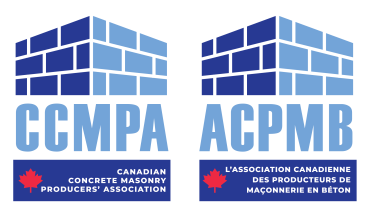
Are you in the know?
I'm Andrea McChesney, the Executive Director of the CCMPA, and we want to ensure you and your team have all the access to the latest and greatest in CCMPA activities and industry buzz.
Sincerely, Andrea & your CCMPA team.

The recent tornado in Goderich and this year’s earlier devastation in Alabama strengthen the case for building with concrete block, brick and stone.
TORONTO — September 20, 2011 — Hotter summers. Heavier rain. More frequent severe storms. These are the effects of climate change, and while building owners can’t directly control them, they can minimize their effects through the use of weather-resistant building materials such as concrete block, clay brick, and stone.
While Environment Canada notes that global temperatures have risen less than one degree over the past 100 years, the agency points out that “even a modest warming of global temperatures would significantly change global wind and precipitation patterns, and hence alter local weather behavior around the world.” The agency also notes that “The number and cost of extreme weather events/disasters (extreme storms, floods, heat waves, droughts, etc.) is rising and new thresholds, regulations, technologies and infrastructure codes and standards need to be developed now to improve the safety of Canadians.”
An example of that extreme weather manifested itself August 21, 2011 in Goderich, Ontario, where an F3 tornado and winds of 280 kmh killed one person and left parts of the town in ruins. While tornados are not unheard of in Canada, the Goderich storm shocked residents with the extent of its devastation.
South of the border, the April 2011 “super outbreak” of tornadoes, which cut through the Southern, Midwestern and Northeastern U.S., is the largest tornado outbreak on record. “There’s no doubt that our weather is becoming more severe, and building regulations today need to reflect that,” says Paul Hargest, President of the Canadian Concrete Masonry Producers Association (CCMPA). “The right building materials are important not only in terms of durability, but also the heavier rain and hotter summers we’re experiencing.”
Concrete block, brick and stone naturally resist moisture, which helps prevent mould, according to research coordinated by the National Research Council of Canada.
Masonry also has the ability to absorb heat from the sun and release it over a period of time, helping to maintain more consistent temperatures in a building and reduce the need for air conditioning as well as lower heating costs.
Masonry may help reduce storm-related fatalities as well. In states such as Alabama, which was especially hard-hit by the April super outbreak, the U.S. Federal Emergency Management Agency has helped fund the construction of masonry storm shelters and safe rooms. The National Storm Shelter Association (NSSA) has also held workshops to educate industry professionals and consumers on how to build these structures. NSSA approved safe rooms can withstand 400 kmh winds and the impact of a 6-kg, 2 X 4 piece of lumber flying at 160 kmh. The worst of the storms that struck Alabama measured EF5 with winds surpassing 300 km/h.
In Florida, meanwhile, efforts to raise building standards and reevaluate building codes have been in effect since Hurricane Andrew struck the state in 1992. In 1995, coastal areas began to use high-wind provisions for residential housing. By 2001 the state had adopted a new Florida Building Code incorporating these new standards. And in certain communities where more advanced construction techniques have been used — for example, anchoring roof trusses to concrete masonry walls — homes have fared far better in severe storms than their wood-frame-and-drywall counterparts.
Today, virtually every state in the U.S. has implemented stricter wind requirements in their building codes. A growing number of homeowners, meanwhile, are expressing interest in masonry as a preventive safety measure.
Although storms in Canada historically have not been quite as severe, the force of the Goderich tornado would indicate that extreme weather should be a greater consideration for Canadian builders. Experience shows that in high winds — particularly those carrying debris — exteriors such as siding and stucco are often damaged. The Insurance Bureau of Canada reports that Canadian governments have spent an annual average of $500 million in recent years to repair extreme-weather damage — damage that might have been lessened considerably through the use of masonry. In Goderich, the Ontario government has pledged a minimum of $5 million to help fund the clean-up.
“Severe weather is a reality that we all face today,” says Paul Hargest. “Today’s building codes need to reflect that.” He questions the merit of altering codes to allow six-storey buildings to be constructed entirely of wood; such legislation now exists in British Columbia. “Designing structures based on tradition does not work,” he says. “We need to design for a world that’s changing — and will continue to change.”
FOR MORE INFORMATION OR TO ARRANGE AN INTERVIEW WITH PAUL HARGEST:
Marina de Souza
Managing Director, CCMPA
Toll Free: 1-888-495-7497
Phone: 416-495-7497
Fax: 416-495-8939
mdesouza@ccmpa.ca
ccmpa.ca
ABOUT CCMPA
The Canadian Concrete Masonry Producers Association operates as Region 6 of the National Concrete Masonry Association, and is the representative voice for the Canadian concrete block manufacturing industry. The Association supports concrete masonry producers and suppliers in a number of areas including standards, training, technological research, government relations, and marketing and communications. Through these areas, the Association works to ensure the highest standards of quality and maintain the industry’s strong market presence.